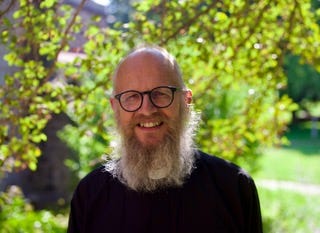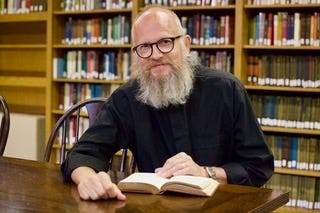Thank you for visiting my web page. I am an ordained priest within the Anglican Church in North America and serve in the Saint Benedict Servants of Christ Chair in Ascetical Theology at Nashotah House Theological Seminary in Wisconsin—a community of formation marked by the fullness of Anglican faith and practice, Benedictine spirituality, and classical Christian thought and teaching. (If you’re interested in studying at Nashotah House, contact me: [email protected].)
Before coming to Nashotah House in 2019, I taught for fourteen years at Regent College in Vancouver, BC and for six years at Trinity Western University in Langley, BC. I grew up in the Netherlands and have been in Canada since 1983.
My interests range across a variety of areas: patristic theology, twentieth-century Catholic thought, and spiritual interpretation of Scripture. In each of these areas, I am driven by a desire to retrieve the ‘sacramental ontology’ of the pre-modern tradition. So, much of my work looks to the past in hopes of recovering a sacramental mindset. I suppose this makes me a ressourcement (retrieval) theologian of sorts. Retrieval of the Great Tradition’s sacramental ontology has been at the heart of almost all my publications over the past ten years or so:
Books on the twentieth-century Catholic thought: Nouvelle Théologie and Sacramental Ontology: A Return to Mystery (Oxford Univ. Press, 2009) and Heavenly Participation: The Weaving of a Sacramental Tapestry (Eerdmans, 2011)
My work on Saint Gregory of Nyssa: Embodiment and Virtue in Gregory of Nyssa (Oxford Univ. Press, 2013)
More recent publications on spiritual or theological interpretation of Scripture: Sacramental Preaching: Sermons on the Hidden Presence of Christ (Baker Academic, 2016); Scripture as Real Presence: Sacramental Exegesis in the Early Church (Baker Academic, 2017); Five Things Theologians Wish Biblical Scholars Knew (IVP Academic, 2021); and Pierced by Love: Divine Reading with the Christian Tradition (Lexham Press, 2023).
A book on the beatific vision—the promise that we will see God in the hereafter: Seeing God: The Beatific Vision in Christian Tradition (Eerdmans, 2018). That topic, too, is closely linked with what I call ‘sacramental ontology.’
In case you’re interested in a very brief clarification, let me explain what I mean by ‘sacramental ontology.’ Ontology is simply talk about reality or about being. I use it pretty much as a synonym for ‘metaphysics.’ Ontological questions concern basic issues of reality, most importantly how we understand the relationship between the sensible world around us and spiritual realities.
I believe in God (the triune God of the Christian tradition, revealed in Jesus Christ), which means I think there’s more than the appearances that we can see and touch. Invisible realities, too, have their place—in fact, they have the most important place. Someone’s ontology or metaphysic explains how that person understands these various aspects of reality to relate to each other. It’s important to note that everyone has an ontology or metaphysic—some hold it consciously, others without realizing it.
So what is sacramental ontology? I unpack this in detail in my book, Heavenly Participation, and what follows here is mostly taken from that book. Perhaps the easiest way of explaining the notion of ‘sacramental ontology’ is by distinguishing between symbols and sacraments. A road sign with the picture of a deer symbolizes the presence of deer in the area, hopefully causing drivers to slow down. Drivers will not be so foolish as to veer away from the road sign for fear of hitting the deer that is symbolized on the road sign. The reason is obvious: the symbol of the deer and the deer in the forest are two completely separate realities. The former is a sign referring to the latter, but in no way do the two co-inhere. It is not as though the road sign carries a mysterious quality, participating somehow in the stags that roam the forests. The symbol and the reality merely have an external or nominal relationship. The distance between the two makes clear that there is no real connection between them. Things are different with sacraments. Unlike mere symbols, sacraments actually participate in the mysterious reality to which they point. When it comes to sacraments, sign and reality co-inhere; the sacrament participates in the reality to which it points.
A sacramental relationship implies that the reality to which the sign points is ‘really present’ in the sign. (The language of real presence probably reminds you of the church’s sacraments, where Christ’s body is ‘really present’ in the elements.) This understanding of sacramentality has a long lineage. According to the sacramental ontology of much of the Christian tradition, the created order was more than just an external or nominal symbol. Instead, it was a sign (signum) that pointed to and participated in a greater reality (res). The reason for the mysterious character of the world—on the understanding of the Great Tradition, at least—is that it participates in a greater reality, from which it derives its being and its value. Hence, instead of speaking of sacramental ontology, we may also speak of participatory ontology.
Why does any of this matter? In modernity, we have come to see the world around us as nothing but symbols: material objects separate from each other and separate from their origin in God (if we still believe in God at all, that is). The secularism of modernity is based on the false premise that the sensible world around is just material stuff, just appearances. Or, to use a fancy theological term, the material world is a world of ‘pure nature’ (pura natura). When we deny that the world around us participates, sacramentally, in eternal realities, we deprive them of meaning. After all, only the invisible reality can give true meaning to the visible sacrament.
Philip Sherrard memorably describes this modern separation between sign and reality in the title of one of his books as The Rape of Man and Nature. One reason we exploit everything (and, perhaps, everyone) for our own selfish ends is that we no longer recognize the world around us as the self-expression of God. By considering things and people as ‘purely natural’—independent from God as the source of their existence—we end up treating them as dispensable ‘raw material.’ The cure for our materialist culture, therefore, is to recognize that, as Maximus the Confessor puts it, the Logos embodies himself everywhere, drawing the entire cosmos (along with us, human beings) back to its ultimate and glorious destiny in him.



